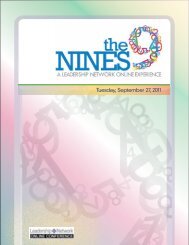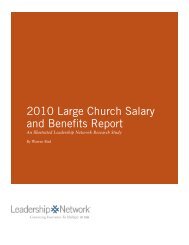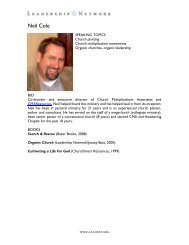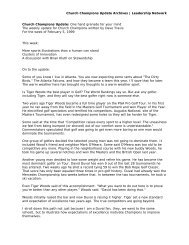ARE WE A PEOPLE AT HALF TIME? - Leadership Network
ARE WE A PEOPLE AT HALF TIME? - Leadership Network
ARE WE A PEOPLE AT HALF TIME? - Leadership Network
You also want an ePaper? Increase the reach of your titles
YUMPU automatically turns print PDFs into web optimized ePapers that Google loves.
(Continued from<br />
Learning<br />
page 1)<br />
The FAST LEARNING/UNLEARN-<br />
ING Gene<br />
Fast Learning is a key to spiritual awakening.<br />
It is time to stop talking about<br />
education and start talking about learning.<br />
Learning encompasses “anytime,<br />
anywhere, anybody, anything.” In fact,<br />
learning may be more central to a spiritual<br />
awakening than worship. Wesley<br />
stressed substantive teaching and<br />
preaching over pandering to new members.<br />
The early Wesleyans were more<br />
concerned about how to send people<br />
out rather than how to seduce them in.<br />
If our churches were sending out educated<br />
disciples, they wouldn’t have to<br />
worry about bringing in new people to<br />
worship. Instead of peopling buildings,<br />
our genes tell us to be building people.<br />
Instead of making programs, it is in our<br />
genes to make disciples.<br />
In one way, the learning gene shifts the<br />
church’s focus from “church growth” to<br />
“church health.” Herein lies our problem<br />
– we have ceased being disciplemaking<br />
churches.<br />
We must free the church’s educational<br />
system from the “lecture-drill-test”<br />
methods of the factory model. Religious<br />
learning systems must be based on new<br />
academic paradigms that shift from<br />
passive learning modes to active learning<br />
modes, especially ones where students<br />
learn habits of the mind and<br />
habits of the soul at their own rate and<br />
in their own areas of special interest.<br />
In short, the changes in our learning<br />
paradigm require new structures<br />
and new core tools for the learning<br />
gene–active learning, interactive learning,<br />
mutual learning, team learning,<br />
service learning, game learning,<br />
leisure/vacation learning, adventure<br />
learning, electronic learning, network<br />
learning, group learning, distance<br />
learning and cyberlearning systems and<br />
programs.<br />
One old/new model of serious theological<br />
education the church needs to consider<br />
is the “seminary” model. The word<br />
“seminary” means literally “seed bed.”<br />
If each congregation were to think of<br />
itself as a “seminary,” a “seed bed for<br />
faith,” and the ordained minister selfconsciously<br />
became a “Dean,” a whole<br />
new approach to the theological education<br />
of baptized ministers would result.<br />
The seminary model proposes the<br />
unleashing and releasing of ministry<br />
leadership among the baptized, showing<br />
them how to live as Christians and how<br />
to help others live as disciples of Christ.<br />
The model features practical courses<br />
for everyday problems as well as more<br />
theoretical courses.<br />
The CELL Gene<br />
Cell<br />
The human body is composed of little<br />
blocks of protoplasm called cells. So is<br />
the body of Christ.<br />
What is a cell A cell connects the<br />
spaces between people and the space<br />
within people. In a world that separates<br />
people from without and fragments<br />
them from within, connections are at<br />
the core of a healthy spirituality. Less<br />
abstractly, a cell is an intentional<br />
group of three to twelve people who<br />
gather together on a weekly basis for<br />
worship, outreach, discipleship, prayer,<br />
pastoral care and evangelism. The cells<br />
do all of the seven pillars of the church<br />
of Acts: studying the Word, worship,<br />
prayer, evangelism, edification, care<br />
and mission. Never larger than fifteen,<br />
they are to meet the needs of the<br />
members as well as to disciple<br />
believers. Most especially, they are<br />
designed to train ministers and<br />
prepare leaders for ministry, and<br />
to teach the lesson of connectedness.<br />
The celling out of the Christian church<br />
is especially crucial in a world that has<br />
“demassified” to a “niche-or-be-niched”<br />
degree (Chuck Fromm) of market fragmentation.<br />
In typical “both/and” postmodern<br />
fashion, the more global the<br />
world we live in, the more individualized<br />
and customized any appeal must be.<br />
Team<br />
The TEAM Gene<br />
Teamwork is part of the postmodern<br />
“horizontal revolution” that is moving<br />
the fulcrums of power from machinebased<br />
to people-based, from pyramid<br />
to pancake, from ladder to web. It is a<br />
“revolution” the church should be leading,<br />
not following, for we of faith are<br />
many, we are legion. The deployment<br />
of team culture in the core space from<br />
which disciples of Jesus live and move<br />
and have their being is one of the most<br />
necessary recapitulations of the<br />
0 2<br />
Christian tradition that must be accomplished<br />
in the postmodern era.<br />
A team does not simply replace or<br />
replicate what is already being done<br />
under the name of “committees.” In<br />
fact, team leadership requires very<br />
different skills from hierarchical<br />
leadership. Team leaders need informal<br />
leadership masteries: the ability to<br />
bring out others’ gifts, manage conflict,<br />
communicate strongly and clearly, build<br />
consensus, affirm diverse gifts. Team<br />
members also need to embrace multiple<br />
leadership roles that can only be<br />
grasped by many hands and many<br />
minds working together. In the star<br />
model of team leadership, there are<br />
key roles for an administrator (record<br />
keeping), facilitator (processing meeting<br />
itself and group identity builder), coach<br />
(helping team members develop their<br />
skills and capabilities and get training),<br />
workload coordinator and external<br />
liaison (group communications).<br />
Jesus invested everything he had in a<br />
team. The Bible knows nothing of solo<br />
ministry, only team ministry. When one<br />
reads the Bible from this standpoint of<br />
teams, what one sees is amazing. The<br />
Bible is the story of collaborations–<br />
Moses and Aaron; Caleb and Joshua;<br />
Esther and Mordecai; Ezra and<br />
Nehemiah; Peter and John; Paul and<br />
Timothy; Barnabus and Mark. Even the<br />
Gospels themselves are presented to us<br />
as a team – Matthew, Mark, Luke and<br />
John.<br />
The early church was dominated, not by<br />
a single, unified thrust, but by a variety<br />
of leadership models and competing<br />
missions (such as Peter and James in<br />
Jerusalem, Paul in various other centers)<br />
that agreed on one thing: the centrality<br />
of Jesus the Christ. The leadership in<br />
the early church was a network of<br />
teams.<br />
Mobilization<br />
The MINISTRY MOBILIZ<strong>AT</strong>ION<br />
Gene<br />
Contrary to what many Christians<br />
think, you don’t need a graduate theological<br />
education to respond to a “call”<br />
to ministry. The rite of “call” is baptism,<br />
not ordination. Every member is commissioned<br />
and installed by baptism to a<br />
“general office” of ministry, educated<br />
and equipped by those set apart for<br />
(Continued on page 3)







